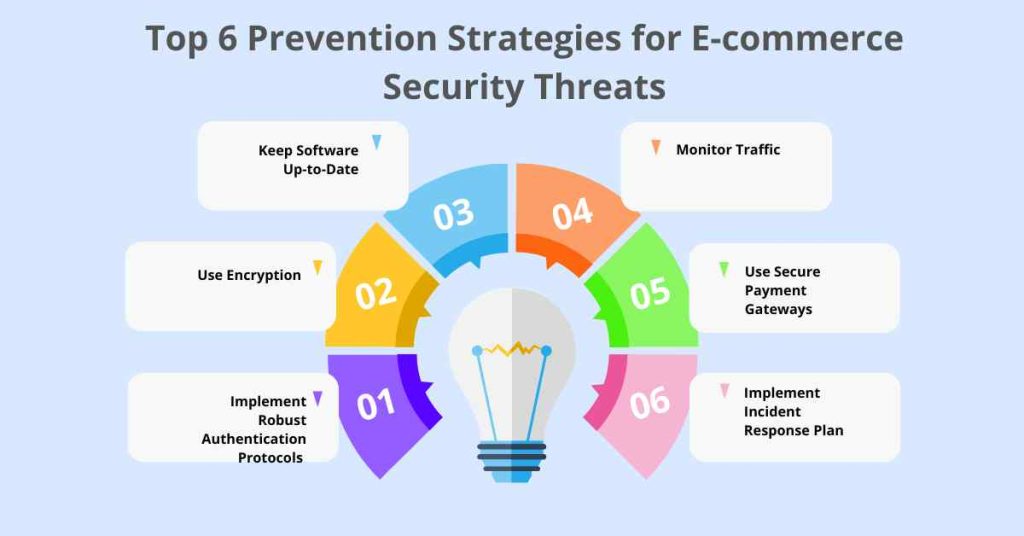The world of E-commerce has witnessed significant growth in recent years, with mobile devices becoming a preferred mode of online shopping. As consumers increasingly rely on their smartphones to browse, compare, and purchase products, mobile commerce (m-commerce) has evolved to become an integral part of the online retail landscape.
With the convenience and accessibility offered by mobile devices, m-commerce is expected to continue growing, presenting new opportunities for businesses to connect with customers and drive sales.
However, the increasing use of mobile devices for online shopping has also created new challenges for businesses in terms of security.
As hackers and cyber-criminals become more sophisticated in their tactics, e-commerce security threats are on the rise, compromising the integrity of mobile applications and putting sensitive customer data at risk.
List of Top 15 Ecommerce Security Threats to Watch for When Launching a Mobile Application

When launching a mobile application, businesses must be aware of the various e-commerce security threats that can compromise the integrity of their platform. Here are the top 15 e-commerce security threats to watch for:
1. Phishing Attacks
Phishing techniques for example are fake emails, messages or notifications sent by an attacker and are designed to make the user divulge information to the attacker.
Customers are easily prone to being trapped with fake websites or links because phishing attacks are more common on mobile applications, and this leads to the loss of customer login details and many other essential details.
2. SQL Injection Attacks
Mobile application attacks involve an attacker introducing negative code into the program’s database to corrupt customer information. These attacks could lead to the loss of clients’ money and the tarnishing of the business’s image.
3. Cross-Site Scripting (XSS)
XSS is a type of e-commerce security threat in which an attacker introduces compiled code into a mobile application’s website or platform. This code can steal customer information, assume the user’s session, or even fully control the mobile device.

4. Man-in-the-Middle (MITM) Attacks
MitM attacks are actual hijackings of the communication channel between a mobile device and the server of a given mobile application and an invasion of customer sensitivity.
These attacks are dangerous in that if not detected and handled appropriately, they are very destructive.
5. Session Hijacking
With session hijacking the attacker gains unauthorized access to the customer information during a session and takes control of the whole session. Precisely, this type of attack can cause serious damage if existing and correctly identified, actions must be taken to address it.
6. Weak Passwords
Inadequate passwords remain one of the largest threats to e-commerce security since they can easily be thwarted by a hacker. Mobile applications have to incorporate strong password policies in addition to the guidelines that users should use unique and complex passwords.
7. Lack of Encryption
Security is paramount when dealing with customer information especially when transferring such data from one point to the other. Mobile applications need to incorporate better-secured data encryption systems to secure customers’ data against access by unauthorized users.
8. Insufficient Server-Side Validation
Lack of server-side validation is a big vulnerability that permits attackers to inject code hence leaving customers’ data vulnerable. Thus, mobile applications must have strong server-side validation to stop such an attack.
9. Cross-Site Request Forgery (CSRF)
Another type of threat that affects e-commerce security is a cross-site request forgery attack where an attacker manipulates a user into doing something that they never intended to do. This attack if not recognized within the shortest time can have adverse effects on the business.
10. Malware
Malware is one of the biggest security concerns of e-commerce organizations, as a result of its damaging impacts on customer records, and a negative effect on mobile application functionalities. This is why mobile applications have no option but to ensure that malware detection and removal mechanisms are well-developed.
11. DDoS Attacks
Most of the app attacks are carried out through DDoS attacks, where traffic flood attacks the server of the mobile application to reduce its performance and availability. It is important for mobile applications to incorporate good DDoS protection mechanisms because of Such attacks.
12. Credential Stuffing
Credential stuffing is another type of e-commerce threat that poses a major risk as the logging details of a mobile application are used in the attack. This attack can be severe if not flagged on time hence the need to seek professional help immediately.
13. Sensitive Data Exposure
This is one of the biggest e-commerce security risks since it causes exposure of some important customer information and financial losses. Due to such exposures, mobile applications must have strict protection mechanisms when addressing data.
14. Lack of Two-Factor Authentication
It is critical to use two-factor authentication to prevent data breaches in customer databases. Mobile applications must also have highly secure two-factor authentication to avoid being vulnerable to such attacks.
15. Old Vulnerabilities
Old vulnerabilities are also capable of exposing important customer data and losses due to such risks. New vulnerabilities must be immediately identified and acted upon, but it also means that applications developed for mobile devices need to have very efficient mechanisms for recognizing old vulnerabilities.
Top 6 Prevention Strategies for E-commerce Security Threats

While the threat landscape is constantly evolving, there are steps that businesses can take to prevent e-commerce security threats:
1. Implement Robust Authentication Protocols
Undoubtedly, strong authentication methods that are more rigid than the standard password to be adopted as two-factor authentication systems are effective in avoiding unauthorized access to the site as well as to other secure customer data.
2. Use Encryption
Security is critical when dealing with customer information, especially when passing information through the network. As the usage of the mobile application increases; it becomes crucial for the application developers to ensure that their customers’ data are safely secured by encryption protocols.
3. Keep Software Up-to-Date
This means that updating software is important for realizing or recognizing vulnerabilities. Application software that is used in mobile devices must have a strong policy regarding vulnerability management in a bid to contain these vulnerabilities.
4. Monitor Traffic
Through traffic monitoring one can have a clue of the security threats that may be in the network to prevent an attack. Mobile applications, specifically must therefore have the necessary monitoring mechanisms in place to monitor such obscurity.
5. Use Secure Payment Gateways
It’s critical to Gateways for payment security and to shield all payment information. Toppers can note that to build up a mobile application, it is compulsory to integrate safe payment gateways to avoid huge losses.
6. Implement Incident Response Plan
Indeed, there are major benefits and risks associated with the following measures Other measures The incident response plan Implementation of an incident response plan assists the organization to cope with security breaches hence avoiding financial losses.
Mobile applications therefore require handling of security incidents where incident response measures need to be put in place.
Summary
Here is the summary for the blog titled Top 15 Ecommerce Security Threats to Watch for When Launching a Mobile Application:
- Phishing Attacks
- SQL Injection Attacks
- Cross-Site Scripting (XSS)
- Man-in-the-Middle (MITM) Attacks
- Session Hijacking
- Weak Passwords
- Lack of Encryption
- Insufficient Server-Side Validation
- Cross-Site Request Forgery (CSRF)
- Malware
- DDoS Attacks
- Credential Stuffing
- Sensitive Data Exposure
- Lack of Two-Factor Authentication
- Old Vulnerabilities
Conclusion
E-commerce security is critical for protecting customer data, preventing financial losses, and maintaining the trust and loyalty of customers.
As mobile commerce continues to evolve, businesses must be aware of the various e-commerce security threats that can compromise the integrity of their platform.
By understanding the top 15 E-commerce security threats to watch for and implementing prevention strategies, businesses can protect their customers and maintain their competitive edge in the market.
FAQs: Top 15 Ecommerce Security Threats to Watch for When Launching a Mobile Application
1. What are the most common e-commerce security threats?
Ans: The most common e-commerce security threats include phishing attacks, SQL injection attacks, cross-site scripting (XSS), man-in-the-middle (MitM) attacks, session hijacking, weak passwords, lack of encryption, insufficient server-side validation, cross-site request forgery (CSRF), and malware.
2. Why is two-factor authentication important for e-commerce security?
Ans: Two-factor authentication is essential for e-commerce security because it provides an additional layer of security that makes it more difficult for attackers to gain unauthorized access to sensitive customer data. By requiring both a password and a second form of verification, such as a fingerprint or a code sent via SMS, two-factor authentication helps prevent unauthorized access.
3. What are the consequences of neglecting e-commerce security?
Ans: Neglecting e-commerce security can have severe consequences, including financial losses, damage to reputation, and loss of customer trust. In addition, businesses may also face regulatory penalties and fines for failing to comply with data protection regulations.
4. How can I protect my e-commerce platform from phishing attacks?
Ans: To protect your e-commerce platform from phishing attacks, implement robust authentication protocols, use encryption to protect customer data, and educate your customers about the risks of phishing attacks. Additionally, consider implementing anti-phishing measures, such as two-factor authentication and verification processes.
5. What are the benefits of using secure payment gateways?
Ans: Using secure payment gateways can help protect sensitive payment information and prevent financial losses. Secure payment gateways also provide a secure and trusted payment process, which can help increase customer confidence and loyalty.
6. How often should I update my e-commerce platform’s security patches?
Ans: It is essential to update your e-commerce platform’s security patches regularly to ensure the integrity of your platform. Regular updates can help prevent vulnerabilities and protect sensitive customer data.
7. What are the signs of a malware attack on my e-commerce platform?
Ans: The signs of a malware attack on your e-commerce platform may include unusual activity, such as increased network traffic, slow platform performance, or changes to your platform’s behaviour. Additionally, malware attacks may also result in unauthorized access to sensitive customer data.
8. How can I prevent session hijacking attacks on my e-commerce platform?
Ans: To prevent session hijacking attacks, implement robust authentication protocols, use encryption to protect customer data, and consider implementing session management techniques, such as cookie encryption and secure tokens.
9. What is the role of vulnerability management in e-commerce security?
Ans: Vulnerability management plays a crucial role in e-commerce security because it helps identify and address vulnerabilities that can compromise sensitive customer data. By implementing robust vulnerability management protocols, businesses can prevent unauthorized access and protect sensitive customer data.
10. How can I ensure that my e-commerce platform complies with data protection regulations?
Ans: To ensure compliance with data protection regulations, implement robust data protection protocols, such as encryption and secure tokenization. Additionally, consider implementing incident response plans and conducting regular security audits to ensure the integrity of your platform.












